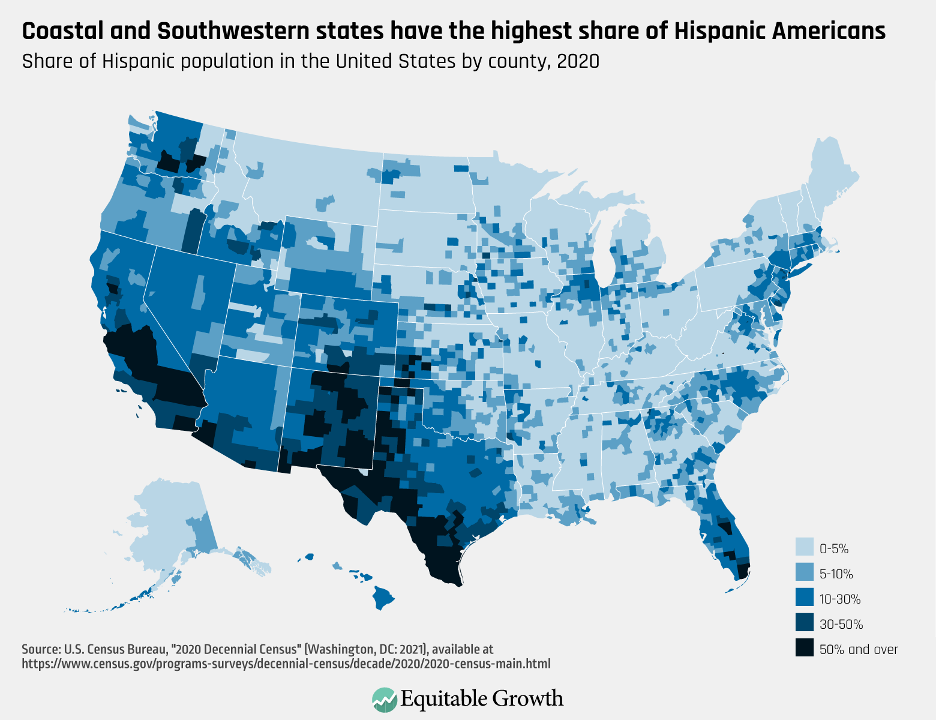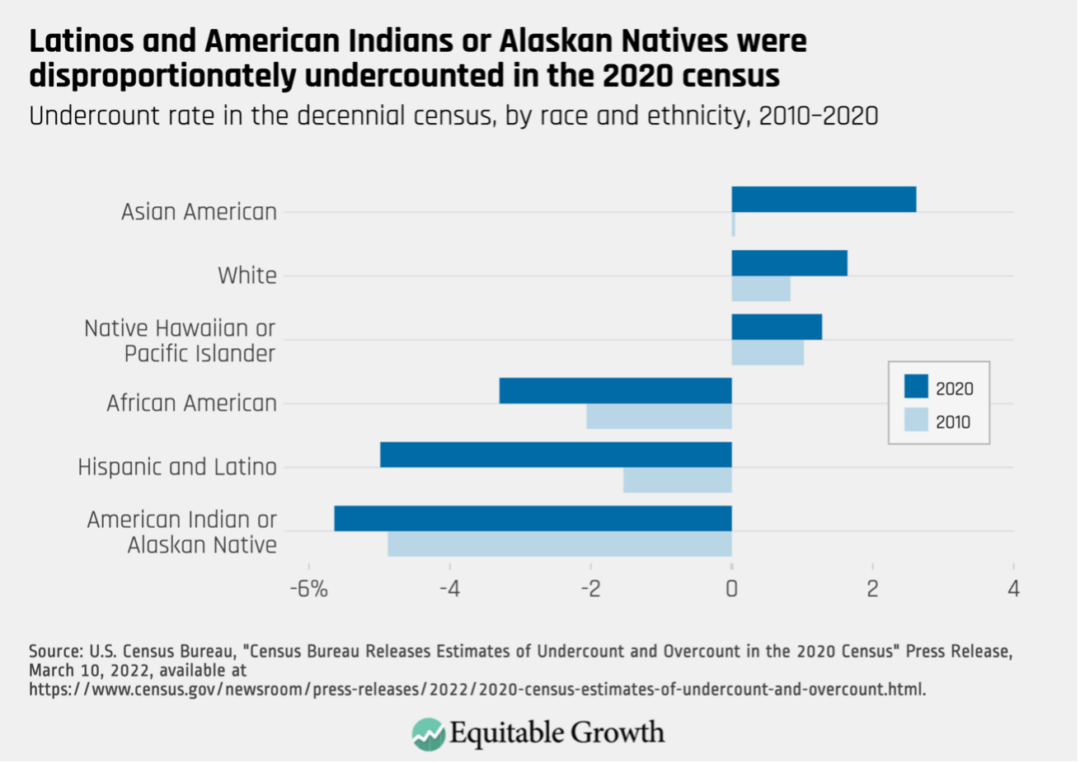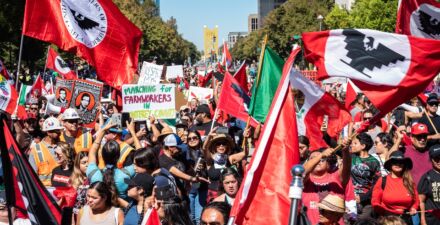What federal statistical agencies can do to improve survey response rates among Hispanic communities in the United States

Between 2010 and 2020, the Hispanic American population grew 23 percent, making it one of the fastest-growing communities in the United States. According to the 2020 decennial census, Hispanic Americans make up 20 percent of the total U.S. population. Figure 1 shows the geographic distribution of Hispanic Americans by county in the 2020 decennial census.
Figure 1

Disaggregating economic and social data by race and ethnicity allows researchers to better understand the socioeconomic well-being of Hispanic communities and other communities and their key contributions to U.S. economic growth, allowing policymakers to create legislation and regulations that tackle the issues these specific communities face.
Yet studies show that Hispanic Americans have a lower response rate to federal surveys than other racial and ethnic groups. In the most recent decennial census, for example, survey collectors reported that Hispanic Americans had the second-highest undercount rate of all racial or ethnic groups after American Indians and Alaska Natives. (See Figure 2.)
Figure 2

Approximately 1 out of every 20 members of the Hispanic community was not counted in the most recent census in 2020. That undercount will impact the creation of local and federal voting districts and the allocation of federal funds for community development in Hispanic-populated regions.
This is not a new issue for the U.S. Census Bureau, and the agency is open to new ways of counting non-White populations. The Census Bureau first began collecting data on Hispanic communities in the 1930 decennial census by including “Mexican” as an option to the race/ethnicity question. Federal data collection has come a long way since then in providing a more inclusive list of race and ethnicity options from which respondents can choose.
The most recent census in 2020 includes options for Hispanic respondents to indicate their country of origin. Adding inclusive race and ethnicity options in surveys is important, but survey collection is only successful if enough members of the population respond to these surveys.
As mentioned above, recent analysis indicates that members of Hispanic communities have a lower response rate to federal surveys than other race or ethnic groups. There are many reasons for the discrepancy in the response rates, but researchers identify three potential causes that have a significant impact on response rates:
- Distrust of government
- Language barriers related to data collection
- Lack of inclusive race and identity options in survey questions
In this column, I briefly survey the current research on each of these three factors. Resolving these discrepancies in response rates will enable policymakers to better understand how economic inequality may be affecting Hispanic communities and enable them to design policies that create more equitable—and thus stronger and more sustainable—economic growth.
Government distrust
Hesitancy in responding to surveys often stems from a general distrust of government or fear of deportation even among those who are legally residing in the country, often because respondents residing legally in the country live with or are related to undocumented immigrants. Federal law states that federal statistical agencies can only use data collected in federal surveys for statistical purposes. In other words, sensitive information from these surveys cannot be shared with other agencies and cannot be used to identify individuals within specific populations.
Yet with the rise in hateful rhetoric about immigrants, often from elected officials, many members of Hispanic communities say they can’t trust the government to protect them, even if their health and safety is at risk. In a recent survey on public trust, only 29 percent of Hispanic respondents said they trust the government in 2022, as opposed to 57 percent of Hispanics in 1998.
These efforts to spur distrust in federal statistical gathering are often calculated. When the Trump administration attempted to include a citizenship question on the 2020 census, for example, Latino advocacy organizations understandably opposed it because they feared it would deter immigrants from responding, leading to an inaccurate count. Importantly, the U.S. Constitution requires that a decennial census be collected on all people living in the United States—not all citizens, which is why a citizenship question was removed from the 1950 census.
The U.S. Supreme Court eventually ruled that the 2020 census would not contain a citizenship question. But the damage was already done: The National Association of Latino Elected and Appointed Officials Educational Fund reported that even after the Supreme Court’s ruling, members of Hispanic communities were hesitant to fill out the survey over fears of a citizenship question.
Despite statistical agencies reassuring respondents that information collected in federal surveys is kept confidential, one Census Bureau study found that 31 percent of Hispanic respondents “were ‘extremely concerned’ or ‘very concerned’ that the Census Bureau would share their answers with other government agencies,” and 34 percent of respondents who answered the survey in Spanish said that they feared that their answers would be used against them. This general distrust in government is present in other demographic groups, but it particularly hurt Hispanic communities in the 2020 decennial census.
In 2015, surveys such as the decennial census and the American Community Survey were used to determine how 132 federal programs distributed almost $700 billion in federal funding. A misestimation of the disaggregated composition of the U.S. population means that this vital funding could ignore thousands of vulnerable households among historically marginalized communities.
Rebuilding trust in government is the first step in improving survey response rates for Hispanic communities. In a series of focus groups of Census Bureau field representatives and supervisors, these representatives indicated that some Spanish-speaking survey respondents were hesitant to complete surveys if they were required to share personal information on surveys. But when they were encouraged to provide fake names, they acquiesced.
Field respondents and the Center for Survey Management consequently recommended that in order to erase some of the distrust in federal surveys, survey questionnaires should include language at the start that ensures anonymity and security of data. Additionally, they recommended that field respondents who go door to door collecting survey data receive training on how to interact with communities who fear government, including clearly identifying themselves as not immigration officers.
Emphasizing the importance of completing surveys for the benefit of individual communities can help erase the distrust component for the sizable survey nonresponse rates among Hispanic populations. In a private study on recruiting Hispanic and Latino survey respondents, the report’s authors indicated that in addition to explicitly stating the privacy measures agencies intend to take to protect individuals’ identities, survey administrators should emphasize the impact that participation may have on respondents’ communities. Stressing the effects that federal survey results have on disproportionately affected communities can inspire individuals to complete surveys in the name of community improvement.
Additionally, a 2015 study of survey response patterns among African Americans and Latinos found that respondents were more likely to participate in and complete a survey if they learned about it though members or agencies within their communities. As such, the Census Bureau partnered with numerous community organizations to try to spread the word about the importance of completing the 2020 census. Going forward, broadening these partnerships for the next census and applying this approach to other federal survey outreach plans, such as those for the American Community Survey and the Current Population Survey, can improve the quality of data collected on the economic and societal well-being of vulnerable populations.
Language barriers and collection methods
After English, Spanish is the most-commonly spoken language in the United States, with more than 42 million people in the country speaking Spanish in their homes. The federal statistical agencies know that to capture an accurate representation of the U.S. population, they need to provide bilingual survey options, especially in Hispanic-populated areas.
The 2020 census was offered in 12 languages besides English. In addition to making it possible for non-English speakers to respond to federal surveys, this practice opens up possibilities for more disaggregated analysis of the U.S. population. The Census Bureau found, for example, that respondents to the Census’ Household Pulse Survey Spanish questionnaire reported double the rates of food insecurity during the COVID-19 pandemic than Hispanic-identifying respondents who took the English version of the survey. This discrepancy could be the result of Spanish-only speakers or those with limited English language proficiency facing economic, social, and health barriers when navigating U.S. institutions and communities that largely favor English.
Bilingual questionnaires are common practice today, but some researchers argue that the existing structures of the administration of bilingual verbal surveys might fail to accurately capture more accurate data. In their National Survey of Latinos, for example, the Pew Research Center conducted over-the-phone surveys using two methods: a fully bilingual method in which interviewers were prepared to collect respondent’s data in either English or Spanish, and a modified bilingual method in which interviewers only spoke English. In this latter method, if interviewers encountered a respondent who preferred to answer the survey only in Spanish, then they would inform respondents that they would instead receive a call from a Spanish-speaking interviewer.
The Pew study found that more interviews with Spanish-language-dominant respondents were conducted with the fully bilingual method over the modified bilingual method. The Census Bureau has already taken steps to ensure the decennial census in 2030 maintains the fully bilingual method for phone interviews. Applying this methodology to all federal surveys, including the American Community Survey and the Current Population Survey, could ensure better-quality information on various communities as a whole.
Noninclusive race and identity options
Confusion over how to identify one’s race and ethnicity has led to inconsistencies in data collection among Hispanic communities. According to the federal government, “Hispanic” is an ethnicity to identify people “of Cuban, Mexican, Puerto Rican, South or Central American, or other Spanish culture or origin regardless of race.”
To help respondents identify themselves within this definition, the federal government, over the past decade, has established a two-question structure for asking respondents about their race and ethnicity: They first ask if respondents are Hispanic or Not Hispanic to determine ethnicity and then ask what race they identify themselves as, with the choices of White, Black, Asian, American Indian or Alaska Native, two or more of these choices, or Other.
Not surprisingly, this type of question structure can cause confusion for those who may consider “Hispanic” to be a race rather than an ethnicity or who don’t identify with the provided race options. In an analysis of the 2010 census, researchers found that 13 percent of respondents who selected “Hispanic” in the ethnicity question left the race question blank, and another 30 percent of such respondents wrote in “Hispanic” for the race question.
Furthermore, a 2015 Pew Research study found that different respondents have very different impressions of what these questions are asking. Their polling found that 42 percent of Hispanic adults consider “Hispanic” to be a matter of one’s culture, while 29 percent said that it was a matter of ancestry and another 17 percent said it was a matter of race.
Results from the 2020 census show that Hispanic respondents primarily identified as being “Some other race” or “White,” yet previous test surveys conducted in advance of the 2010 census found that most Hispanic respondents who selected “White” as their race did not actually identify as White but did so in order to complete the survey. When Hispanics select “Some other race,” they are putting themselves in a category that also includes Middle Eastern and North African respondents and many others.
In fact, “Some other race” is now the second-most frequently selected category on the Census after “White.” The category has become so large, it has little analytical value, and its catch-all quality is obscuring the true number of Hispanics in the United States.
In order to dispel confusion surrounding race and ethnicity and improve the accuracy of self-reported race statistics, federal statistical agencies have been experimenting with the structure of this question. In 2016, the Census Bureau studied what the effects a combined race and ethnicity question would have on survey responses. This structure added “Hispanic, Latino, or Spanish origin” to the list of previously designated races and asked respondents to write out their origin.
The results indicate that this structure not only made it easier for Hispanic respondents to accurately self-identify their race and ethnicity, but also improved the accuracy of those who identified as Hispanic and another race category. Under this new structure, for example, someone who identified as Hispanic and Dominican would be able to identify as such, rather than Hispanic and “Some other race.”
Demographic experts suggest that adopting this approach to federal survey collection, not just in the decennial census but also across all federal surveys, would reduce the share of Hispanic respondents identifying as “Some other race” and could improve Hispanic undersampling rates.
Conclusion
Fixing the nonresponse problem in the collection of federal survey data is not easy. It requires federal survey administrators to assess the causes in each community and be attentive to building public trust, breaking down language barriers, and establishing more-inclusive identity questions. In their efforts to improve response rates among the Hispanic community in advance of the 2030 decennial census and other federal data collection efforts, federal statistical agencies should revisit current practices to ensure they are leveraging the newest research on factors that influence response rates for Latinos and other ethnicities.
Incorporating this approach can lead to improved representation of Hispanic and Latino communities, better funding for programs vital to these communities, and a greater sense of inclusivity among all demographic groups in America. The resulting data would enable U.S. policymakers to produce more equitable economic policies that, in turn, drive stronger and more sustainable U.S. economic growth.







